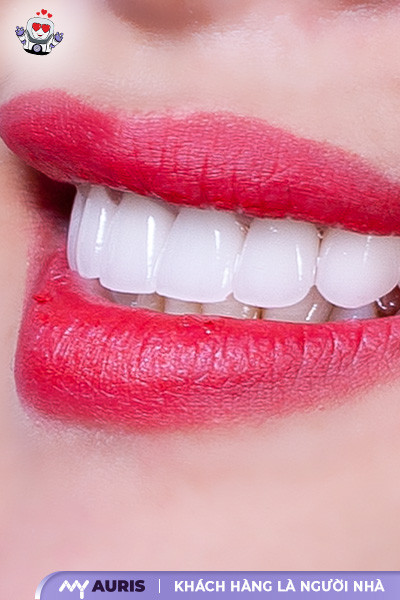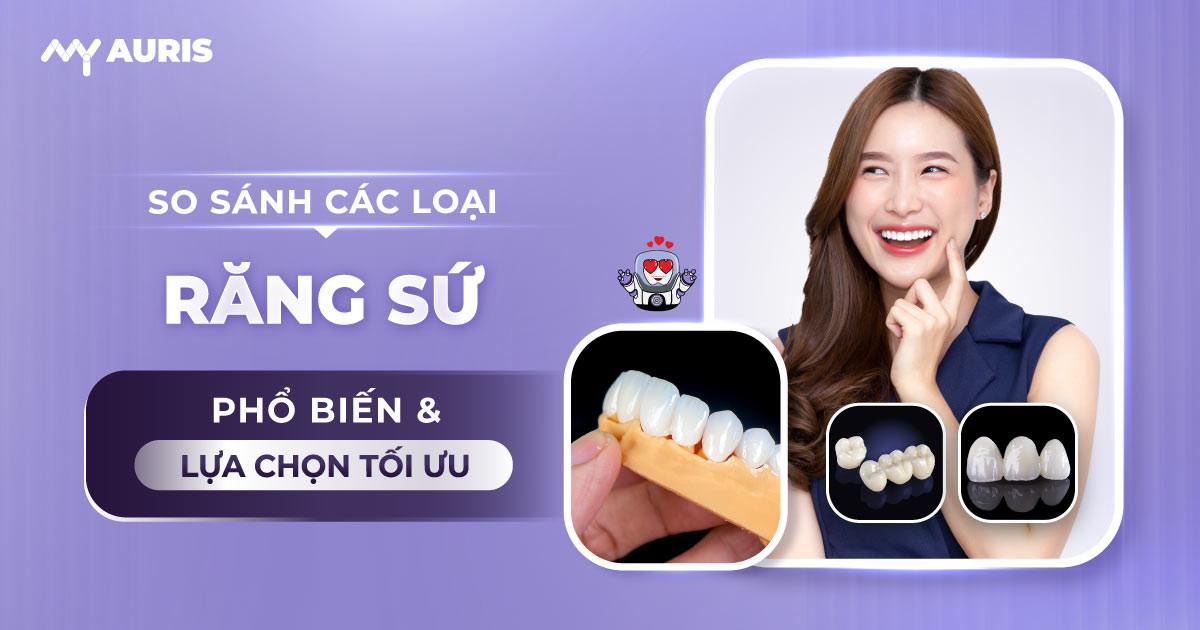The dentition plays a crucial role for the face, affecting health, aesthetics, and human confidence. When teeth are damaged, dental restoration with porcelain crowns is a necessary solution. Choosing the right type of dental crown depends on many factors, including oral health, cost, and aesthetic desires. This article by My Auris will compare popular types of dental crowns, helping you understand the advantages and disadvantages of each to make an informed decision.
Overview of Porcelain Crowns and Restoration Needs
What are Porcelain Crowns? Why Do We Need Them?
Damaged natural teeth cause difficulty chewing. Porcelain crowns (“dental crowns” or “tooth capping”) are a solution. Dental ceramic materials, such as Zirconia or Porcelain, create these artificial teeth. Porcelain crowns restore teeth, improving dental aesthetics and chewing strength. The need for porcelain crowns stems from the desire for beautiful, healthy teeth, correcting imperfections such as chipped, broken, discolored, or misaligned teeth.
Porcelain crowns provide a confident smile. They help you communicate and eat comfortably. The lifespan of porcelain crowns is long if cared for properly.

Main Types of Teeth and Their Role in Jaw Structure
The dentition consists of several types of teeth: incisors, canines, premolars, and molars. Each type has its own role. Incisors are used for biting and tearing food. Canines tear tough food. Premolars and molars grind food. The structure of the dentition affects the mouth, face, and the entire body. Gingivitis, if left untreated, can lead to tooth loss. Proper oral care helps maintain a healthy, natural set of teeth.
Teeth play a crucial role in chewing and speaking. Tooth loss affects health and aesthetics. Dental implants, bridges, and dentures are methods to replace lost teeth. Orthodontics helps adjust tooth positions, improving occlusion. Teeth whitening makes teeth brighter.
Importance of Choosing the Right Type of Porcelain Crown
Choosing the right type of porcelain crown is important. It affects dental aesthetics, crown durability, treatment cost, treatment duration, and invasiveness. Comparing different types of porcelain crowns helps you understand their advantages and disadvantages. Types of porcelain crowns include all-ceramic crowns (Zirconia, Cercon, Nacera) and metal-ceramic crowns (Titan). Each type has its own pros and cons. The origin of the ceramic blank, the manufacturing technology of the crown, and international quality certifications are important factors.
Choosing the right type of porcelain crown helps you have beautiful, durable teeth that suit your face and body. Good porcelain crowns have natural translucency and color, are wear-resistant and stain-resistant, fit accurately on natural teeth, and provide a high level of comfort during use.
Factors Influencing the Decision to Choose Porcelain Crowns
Many factors influence the decision to choose porcelain crowns. The current tooth condition, the position of the tooth needing restoration, budget, and desired aesthetics are key factors. Incisors require high aesthetic quality. Molars need durability and chewing strength. The cost of different types of porcelain crowns varies.
Comparison of Popular Porcelain Crown Types
Metal-Porcelain Crowns
Metal-porcelain crowns are a cost-effective tooth restoration option. A metal framework is covered with porcelain on the outside. Metal-porcelain crowns have high durability and good chewing strength.
Advantages: Metal-porcelain crowns are noted for their durability and low cost. They have good chewing strength, making them suitable for molars. Treatment time is quick and minimally invasive.
Disadvantages: The metal can cause gum irritation and inflammation. Aesthetic appeal is limited, and a dark gum line may appear after some time of use. The color of metal-porcelain crowns is less natural.

All-Ceramic Crowns
All-ceramic crowns are made entirely from high-grade dental ceramics such as Zirconia and Cercon. This type of crown offers high aesthetic appeal and excellent biocompatibility with the body.
Advantages: All-ceramic crowns offer superior aesthetics, natural color, high translucency, closely resembling natural teeth. They have good biocompatibility, do not cause gum irritation, and are safe and benign. They are also wear-resistant and stain-resistant.
Disadvantages: The cost of all-ceramic crowns is higher than metal-porcelain crowns. Some types of all-ceramic crowns have lower chewing strength than metal-porcelain crowns.

Comparison of Specific Metal-Porcelain Crown Types
Metal-porcelain crowns come in various types, each with its own advantages and disadvantages.
- Titanium porcelain crowns: Titanium is a light, durable metal. Titanium porcelain crowns have better durability than regular metal-porcelain crowns and are less likely to cause allergies.
- Chrome-Cobalt porcelain crowns: Chrome-Cobalt is harder than Titanium. High durability, low cost. However, it is heavier than Titanium and can cause irritation in some people.
- Precious metal porcelain crowns: (Gold, Platinum) Exceptionally good biocompatibility. Less likely to cause allergies or gum inflammation. High cost.
Comparison of Premium All-Ceramic Crown Types
- Zirconia crowns: High hardness, good strength. Suitable for molars.
- Cercon crowns: A balance between aesthetics and durability.
- Nacera crowns: Natural translucency and color. High aesthetic appeal.
- Emax crowns: Made from Lithium Disilicate. Hard and beautiful.
Overall Comparison Table of Porcelain Crown Types
| Criteria | Metal-Porcelain Crowns | All-Ceramic Crowns |
| Durability | High | Medium – High |
| Aesthetics | Low | High |
| Cost | Low | High |
| Lifespan | Relatively long | Long |
| Safety | Medium | High |
Pros and Cons of Porcelain Crowns and Considerations
Benefits of Porcelain Crowns
Porcelain crowns offer many benefits for your teeth and face. Improving your smile is a prominent advantage. Porcelain crowns cover imperfections, creating beautiful, natural tooth shapes that harmonize with your face. Dental ceramic materials have high dental aesthetics, natural color, and translucency. All-ceramic crowns like Zirconia, Cercon, and Nacera are renowned for their superior aesthetics. The durability of porcelain crowns is high, with good chewing strength, making them comfortable to use.
Limitations and Risks of Porcelain Crowns
Despite numerous advantages, porcelain crowns also have some limitations. The cost of porcelain crowns is relatively high, especially for premium all-ceramic types like Ceramill and Zolid. There is a certain degree of invasiveness in the porcelain crowning process. The dentist grinds down a portion of the natural tooth to create space for the crown. In some cases, complications such as gingivitis or exposed tooth margins may occur after crowning. Metal-porcelain crowns carry a risk of irritation and a dark gum line. The treatment duration for porcelain crowns can vary depending on the tooth condition and the type of crown. Meticulous and proper care of porcelain crowns is essential to avoid oral health issues.

Factors to Consider When Getting Porcelain Crowns
When choosing porcelain crowns, you need to carefully consider the following factors: Type of crown (all-ceramic, metal-porcelain), dental ceramic material (Zirconia, Titanium, Porcelain), cost, treatment duration, aesthetic outcome, safety, and biocompatibility. The origin of the ceramic blank, the manufacturing technology of the crown, international quality certifications, and the specific warranty period for each type of ceramic are also important factors. Chewing strength, natural translucency and color, wear and stain resistance, accuracy when fitted on natural teeth, and comfort during use should also be considered. Choosing a reputable dental clinic with an experienced dentist is a decisive factor for the success of your porcelain crown treatment.
Advice on Choosing the Right Porcelain Crown Type
The position of the tooth influences the choice of ceramic material. Incisors require high aesthetic quality, so all-ceramic Zirconia or Cercon crowns are preferred for their natural translucency and color.
Dental aesthetics is an important factor. If you desire a bright, natural smile, all-ceramic Nacera, Cercon, or DDbio crowns are good choices. Metal-porcelain crowns can cause a dark gum line after some time, affecting aesthetics.
The cost of porcelain crowns varies by type. Metal-porcelain crowns have a lower cost than all-ceramic crowns. However, metal-porcelain crowns can cause a dark gum line after some time, affecting aesthetics. Premium all-ceramic crowns like Zirconia and Cercon offer high safety and aesthetics but come at a higher cost.
Overall oral health, such as gingivitis, affects the choice of porcelain crown type and the crowning procedure. The dentist will assess your oral condition and advise on the appropriate ceramic type.
An experienced dentist will evaluate your tooth condition, face, aesthetic needs, financial capacity, and advise on the suitable type of porcelain crown, dental ceramic material, and crown manufacturing technology.





